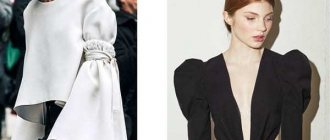As we know, beauty is in the eye of the beholder, but the eyes can see things completely differently depending on place and time. It was with the aim of proving this that a photo shoot was held, demonstrating how the concept of perception of female beauty and the standards that define this beauty have changed over several millennia. We all probably have at least some idea of how women from all of these historical periods shown in the video dressed. But the idea that at different times and eras there were completely different ideas about the ideal body may not have occurred to many of us.
Ancient Egypt (1292-1069 BC)
Slender
Narrow shoulders
High waist
Symmetrical face
Numerous frescoes give a fairly complete picture of what ideal Egyptian women should have been like. The ideal of female beauty in Ancient Egypt was considered to be a tall, slender brunette with broad shoulders, a flat chest, boyishly narrow hips and long legs. The Egyptians sought to ensure that their skin was smooth, without a single hair, so thousands of years ago they practiced wax epilation, which is also known to our contemporaries. After hair removal, the skin was anointed with oils and incense, and with the help of whitewash it was given a “fashionable” light yellow tint. For men, a different skin color was valued - red-brown. The ideal of female beauty in Ancient Egypt suggests that the Egyptians generally lived well. There were wars, but they did not bleed the country, there was no overpopulation either, so the standard of female beauty was far from the Paleolithic Venus. In the women of Ancient Egypt, we see the influence of such a phenomenon as neoteny, that is, the preservation of childish traits in adult women. The desire for this type of beauty manifests itself in societies where the need for childbearing is low.
1950: Marilyn Monroe and Audrey Hepburn

The war is over, and now girls can spend all their free time on beauty! Makeup is becoming more dense and “artificial”: porcelain skin, drawn-on spots and bright glossy lips are in fashion. Smooth hair is a thing of the past! They have been replaced by high hairstyles, comb-overs and curls, and hydrogen peroxide is now the most popular pharmacy product, because beauties use it to lighten their curls. Girls still look to actresses, the main characters of the 50s being Marilyn Monroe and Audrey Hepburn.
[region:bone:inline_1]
Ancient Greece (500-300 BC)
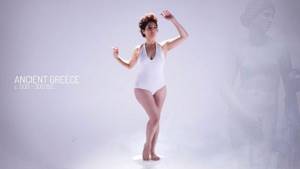
Plump
Round, curvy shapes
Bright skin
Women were considered a "shapeless" version of men
In Ancient Greece, beauty was a cult. Moreover, it was here that the concept of the ideal acquired completely quantifiable parameters. We are talking about the “golden ratio”. The calculation of beauty standards was made by the ancient Greek sculptor Polykleitos in the 5th century. BC. in the essay "Canon". In his opinion, the ideal body should be like this: the head should be 1/7 of the total height, the hand should be 1/10, the foot should be 1/6, and the center of the body should be at the level of the navel. The waist to hip ratio was also taken into account. It was calculated by dividing the first indicator by the last. The waist, say, 60 cm, is divided by the hips - 90 cm. It turns out to be approximately 0.66. For the owner of the golden ratio, this figure will be 0.7. Anthropologists have established that the division of the human body by the navel point is the most important indicator of the “golden section”. Male proportions range from an average ratio of 13 to 8 (1.625). They are closer to the “golden ratio” of 1.618 than the female ratio, which is 8 to 5 (1.6). In Ancient Greece, townspeople lived in poleis, famine was rare, but wars required constant replenishment of the army. This led to a harmonious ideal of female beauty, not anorexic, but not hypertrophied-paleovenous.
Greece and Rome
Aphrodite can be considered the standard of a beautiful body among the Greeks: height - 164 cm, chest circumference - 86 cm, waist - 69 cm, hips - 93 cm. The beauty of her face was determined by the so-called Greek nose, low forehead and large eyes.
In Ancient Rome, the cult of fair skin and blond curls dominated, so it was the Romans who were the first to master the secrets of natural hair bleaching.
( Also read: The Miracles of Coconut Oil for Beauty).
Italian Renaissance (1400-1700)
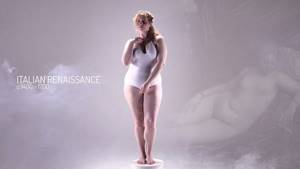
Lush bust
Round belly
Full hips
Bright skin
If you look at female portraits from the Middle Ages and images of female beauty from the Renaissance, then the manifestation of the K-strategy is obvious. Life in cities during the Middle Ages was not easy: overcrowding, unsanitary conditions, hunger, religious dogmatism. The population is over 100 million people. In a word, not life, but a fairy tale. Scary. The ideal of female beauty of that time was women who were pale, eyebrowless and asexual. They shaved their foreheads and wore fake bellies to simulate pregnancy. Adjustments were made by wars and the plague, which wiped out the population of entire cities. Therefore, during the Renaissance, the ideals of female beauty changed exactly the opposite. Europe needed to replenish its population, so “Ruben’s women” came to the fore, whose figures seemed to be created for assembly-line childbearing.
Beauty in the Renaissance
Renaissance (1400-1700)
Renaissance Italy was a Catholic, patriarchal society. Women were expected to embody all virtues and were often separated from the male sex, both in society and at home.
The meaning and value of a woman was associated with her service to a man, God, father or husband.
It was believed that a woman's behavior and appearance reflected her husband's status. Beauty in Renaissance Italy meant that a woman should have the following appearance criteria:
- Pale skin
- Curvy shapes, including full hips and large breasts
- Blonde hair
- High forehead
Victorian era (1837-1901)
The Victorian era in England lasted during the reign of Queen Victoria. She was the most influential figure of the era. The young queen was also a young wife and mother.
In Victorian society, thriftiness, family and motherhood were highly valued. These virtues were embodied in Queen Victoria herself.
Roaring Twenties (1920s)

Flat chest
Undefined waist
Hairstyle – short bob
Boyish figure
A clear leap in ideas about the standards of female beauty began in the 20th century. From a woman of decadence, whose one appearance showed that with one leg she was already beyond the boundaries of this world (pallor, dark circles under the eyes, black clothes), the ideal of beauty was replaced by a full-blooded, athletic, broad-shouldered woman. This happened against the backdrop of the consequences of the First World War and growing emancipation. If you look at the ideal women of the 1930s in Germany and the USSR, it will be difficult to notice the difference: countries preparing for mass confrontation needed soldiers. The beauty standard chosen after the First World War corresponded perfectly to this attitude: a healthy, strong woman, the cult of sports - healthy offspring.
Beauty in different eras
The Screaming Twenties (1920s)
In 1920, women in the United States gained the right to vote, and this set the tone for the entire decade. Finally, representatives of the fairer sex felt equality and freedom.
Women who obtained jobs during World War II expressed a desire to continue working after the war ended.
The so-called androgynous appearance came into fashion; women tried to visually make their waists appear lower and wore bras that flattened their breasts.
In the 20s of the last century, a woman with a boyish figure, a complete absence of curvaceous figures, and small breasts was considered beautiful. The bob haircut was also in fashion.
Driving Sixties (1960s)
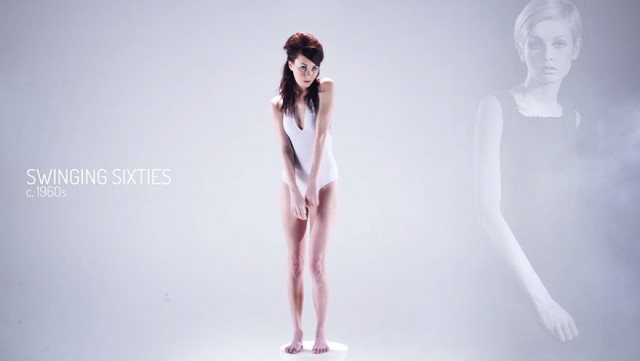
Flexible
Thin
Long, slender legs
Teenager's physique
Having become fed up and growing in population, already in the mid-1960s the world began to admire Leslie Hornby, or Twiggy: thin, branchy legs, short hair... According to many fashion historians, Twiggy can be called the first supermodel. Millions of girls around the world lost weight to the point of exhaustion (“Twiggy syndrome”), copied the makeup and unusually short haircut of the big-eyed model. Twiggy became a real calling card of the decade.
Hollywood beauty standard
Hollywood's Golden Age lasted from the 1930s to the 1950s. During this time, the Hays Code was in effect, establishing moral standards for what could or could not be said, shown, or implied in a film. The code limited the types of roles women could play, creating an idealized image of the lady that spread throughout the world. Movie stars of the time, such as Marilyn Monroe, showed off her curvy figure with a thin waist .
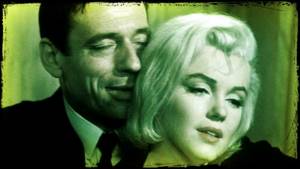
The ideal woman in the Hollywood era
Postmodern beauty (2000s – today)
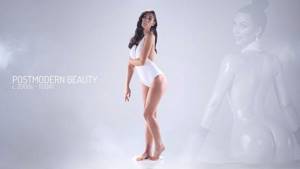
Slim stomach
"Healthy" thinness
Large breasts and buttocks
Space between inner thighs
Women regularly resort to plastic surgery to achieve their desired appearance.
Beauty standards continued to change and are still changing. Anorexia is gradually disappearing, and the trend of “natural beauty” is gaining momentum in the world.
2000: Gisele Bundchen and Britney Spears
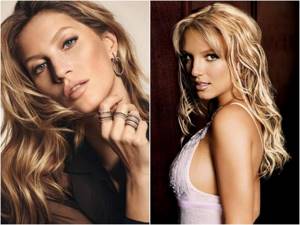
Oh, sport, you are the world! Slender and fit girls with athletic builds are in fashion. Particular attention to the abdominal press - girls are ready to pump it all day long just to see the treasured six-pack. They have no time for makeup: lip gloss and mascara are the most they had time for during the break between workouts. The title of the most beautiful girl in the world goes to Gisele Bundchen, and young people are “crazy” for young Britney Spears.
40s
War is coming. At the beginning of the decade, glamor faded; there was simply no time for it. Militarized fashion dictates broad shoulders and women's versions of men's suits.
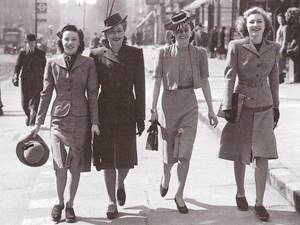
After the war, Dior and his New Look concept happened to the fashion world. The woman becomes incredibly elegant, refinedly feminine.
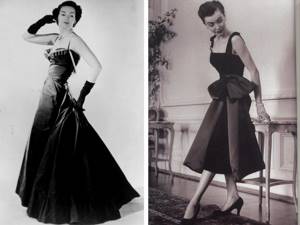
Christian Dior New look.
And then the legendary 90-60-90 appear.
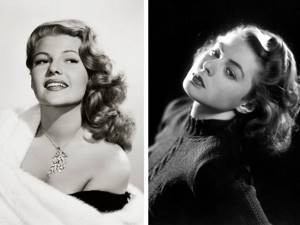
Rita Hayworth, Ingrid Bergman
00s
The 2000s were a response to the “heroin chic” of the previous decade. Strong and toned bodies replaced lifeless and thin ones. But a thin waist and slender legs were still in favor. Tyra Banks and Gisele Bündchen have become ideals of figure and beauty. The girls could confidently walk down the podium and win the fitness competition.
Women emphasized their ideal body with low-rise jeans, crop tops and mini lengths. Let's remember the images of Paris Hilton and Rihanna: it was impossible to hide anything unnecessary behind tight trousers and tops.
Long hair, thin eyebrows, from which Cara Delevingne would so successfully save us later, and smokey eyes makeup were also considered an attribute of beautiful appearance.

Paris Hilton, Rihanna
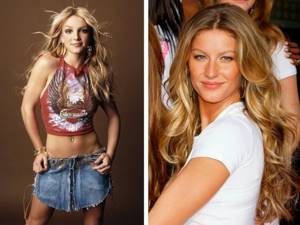
Britney Spears, Gisele Bündchen
90s
These are truly dashing. Legendary supermodels also mixed here: Cindy Crawford, Claudia Schiffer, Naomi Campbell, Linda Evangelista, Christy Turlington with their elegance and charisma, and heroin chic from Kate Moss.
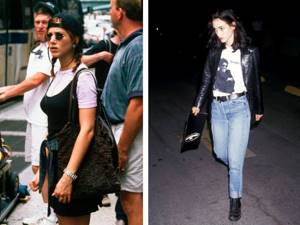
Jennifer Aniston, Winona Ryder
The phrase from Evangelista “I won’t even get out of bed for less than 10 thousand dollars” becomes iconic for this time. From Moss we inherited the fashion for an unhealthy appearance, paleness, tangled hair and thin collarbones. But everything passes, and it has passed.
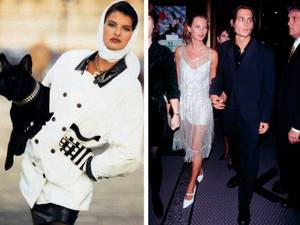
Linda Evangelista, Kate Moss
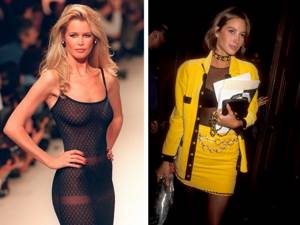
Claudia Schiffer, Christy Turlington
80s
Society finally came to its senses after the war, saved up some money and began to spend a lot and with pleasure.
The two main images of the time were ostentatious sexuality and successful success.
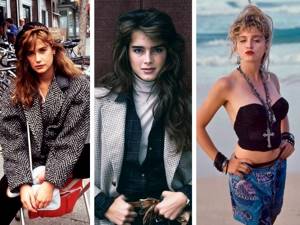
Demi Moore, Brooke Shields, Madonna
At the same time, Cindy Crawford and Jane Fonda appear with aerobics on videotapes. A woman should be healthy and beautiful. The cult of the body begins, the fashion for tanning and perms is established.

Cindy Crawford, Jane Fonda
Top models are finally becoming part of pop culture.






